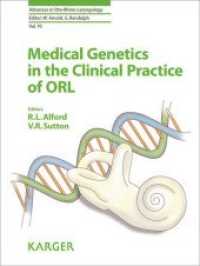Full Description
Geographical Information and Urban Transport Systems
Urban transport systems need to be analyzed from various perspectives: the offer on one hand, the demand on the other hand, but also their negative externalities (risks of transport systems). These three dimensions are rarely apprehended in an integrated perspective. This book provides a large collection of chapters dealing with these specific dimensions, each written by recognized specialists in their domain, and articulates them in an integrated way.
Contents
Introduction xi
Arnaud BANOS and Thomas THÉVENIN.
PART 1. CHARACTERIZATION OF TRANSPORT SUPPLY 1
Chapter 1. Modeling Transport Systems on an Intra-Urban Scale 3
Thomas THÉVENIN
1.1. Introduction 3
1.2. GIS-transport experiments 4
1.3. Towards an urban GIS-T 9
1.4. Towards an analysis of accessibility 17
1.5. Conclusion 26
1.6. Bibliography 27
Chapter 2. Determining Urban Public Transport Supply 31
Robert CHAPLEAU
2.1. Introduction 31
2.2. Considering time in journey planning 35
2.3. Geometry of a collective urban transport network: expressing interconnectivity 36
2.4. Calculating resources according to transport network coding 42
2.5. Visualizing the transport network from different perspectives 43
2.6. Conclusion: GIS as an analysis and intervention platform 50
2.7. Bibliography 51
Chapter 3. Defining Intermodal Accessibility 53
Alexis CONESA and Alain L'HOSTIS
3.1. Introduction 53
3.2. Accessibility 54
3.3. Intermodality and multimodality 60
3.4. Modeling the transport system: networks and graphs 61
3.5. Example on an urban scale: access to the Lille campus 63
3.6. Conclusion 75
3.7. Bibliography 77
Chapter 4. Characterizing Form and Functioning of Transportation Networks 83
Cyrille GENRE-GRANDPIERRE
4.1. Introduction 83
4.2. Precautions and limitations in describing form and functioning of transportation networks 85
4.3. Examples of induced effects related to the form and functioning of transport networks 104
4.4. Conclusion 111
4.5. Bibliography 111
PART 2. ESTIMATING TRANSPORT DEMAND 115
Chapter 5. Estimating Transport Demand 117
Patrick BONNEL
5.1. Introduction 117
5.2. Modeling history 118
5.3. Methodological framework 122
5.4. Constructing geographical information: from the zonal system to the network structure 134
5.5. Constructing origin/destination matrices 140
5.6. Mode choice and route assignment 151
5.7. Conclusion 162
5.8. Bibliography 164
Chapter 6. Visualizing Daily Mobility: Towards Other Modes of Representation 167
Olivier KLEIN
6.1. Introduction 167
6.2. Essential preconditions 168
6.3. Classic limited cartographical approaches 182
6.4. An answer by geovisualization 195
6.5. Conclusion 214
6.6. Bibliography 214
Chapter 7. Guiding a Tram-Train Installation: a Necessary Multi-Criteria Approach 221
Olivier BOUHET
7.1. Introduction 221
7.2. The tram-train 224
7.3. The tram-train project in the urban region of Grenoble 228
7.4. A two tool method: GIS and MCA 233
7.5. Result analysis 243
7.6. Conclusion 256
7.7. Bibliography 258
List of Authors 261
Index 263








